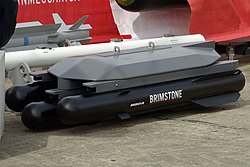This article needs additional citations for verification .(August 2019) |

Fire-and-forget [1] [2] is a type of missile guidance which does not require further external intervention after launch such as illumination of the target or wire guidance, and can hit its target without the launcher being in line-of-sight of the target. This is an important property for a guided weapon to have, since a person or vehicle that lingers near the target to guide the missile (using, for instance, a laser designator) is vulnerable to attack and unable to carry out other tasks.
Contents
Generally, information about the target is programmed into the missile just prior to launch. This can include coordinates, radar measurements (including velocity), or an infrared image of the target. After it is fired, the missile guides itself by some combination of gyroscopes and accelerometers, GPS, onboard active radar homing, infrared homing optics, and anti-radiation homing. Some systems offer the option of either continued input from the launch platform or fire-and-forget.
Fire-and-forget missiles can be vulnerable to soft-kill systems on modern main battle tanks, in addition to existing hard-kill systems. As opposed to unguided RPGs which require a hard-kill system (a counter projectile(s) used to destroy the incoming missile), fire-and-forget missiles can often be jammed by means such as electro-optical dazzlers.
